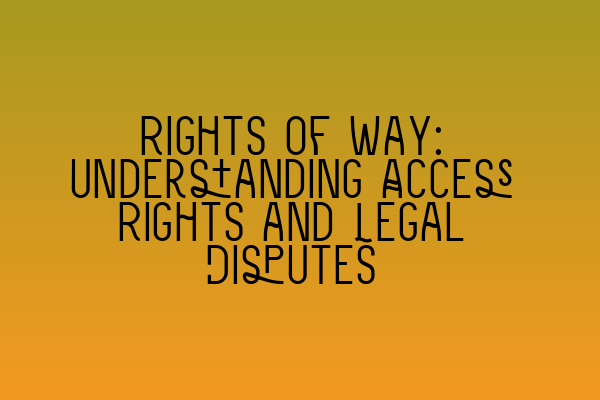Rights of Way: Understanding Access Rights and Legal Disputes
When it comes to property law, one important aspect to understand is the concept of rights of way. Rights of way pertain to the legal right to access or pass through another person’s land, typically for the purpose of reaching a specific destination. Whether you are a property owner or a potential buyer, it is crucial to have a clear understanding of access rights and the potential legal disputes that may arise.
Types of Rights of Way
There are several types of rights of way, each with its own unique characteristics and legal implications. It is important to be familiar with these types to better navigate any potential disputes or agreements.
1. Public Rights of Way
Public rights of way, also known as highways, are typically established by law and are accessible to the general public. They can include footpaths, bridleways, and byways, providing access to specific areas like parks, public land, or even scenic routes. These rights of way are subject to regulations and may require permission or licenses for certain activities.
If you are a property owner that adjoins a public right of way, it is essential to understand your responsibilities and potential limitations regarding maintenance and usage.
2. Private Rights of Way
Private rights of way are specifically granted to individuals or groups for specific purposes. These rights are typically established through legal agreements, such as easements or deeds, and are limited to the defined beneficiaries. Private rights of way may involve access to residential properties, agricultural land, or even shared driveways in a housing estate.
If you are considering purchasing a property with a private right of way, it is crucial to thoroughly review the terms and conditions associated with the right of way to ensure it meets your specific needs. Additionally, it is advisable to seek legal advice to fully understand the nature and enforceability of the right of way.
3. Prescriptive Rights of Way
Prescriptive rights of way are rights granted through continuous and uninterrupted use over a long period of time. They can be established when someone openly and without permission uses a specific path or access route for a considerable amount of time, typically 20 years or more.
Prescriptive rights of way can be complex legal issues, as they require evidence of continuous use and can cause disputes between property owners. If you believe you have acquired a prescriptive right of way or if someone claims such right on your property, it is recommended to seek legal advice to understand your rights and obligations.
Common Legal Disputes
While rights of way provide important access rights, they can also be a source of legal disputes between property owners. Understanding the common disputes that can arise will help you navigate these situations more effectively.
1. Restrictive Practices
In some cases, property owners may place restrictions on the use of a right of way. These restrictions can include limitations on the type of vehicles allowed, hours of access, or even the right to access altogether. If these restrictions are not clearly defined and agreed upon, they can lead to conflicts between parties.
If you encounter restrictive practices that you believe are unfair or unreasonable, it is advisable to seek legal advice to understand your rights and to potentially negotiate a resolution.
2. Encroachment
Encroachment refers to a situation where someone obstructs or interferes with a right of way by placing objects or structures on the path or limiting access. This can occur intentionally or inadvertently, and it can significantly impact the rights and usability of the right of way.
If you experience encroachment or if someone claims that you are encroaching on their right of way, it is important to consult a solicitor who specializes in property law. They can help you assess the situation, negotiate a resolution, or potentially pursue legal action, depending on the circumstances.
3. Disputed Ownership
Disputes over rights of way can also arise when there are disagreements regarding ownership or the validity of the right of way. These disputes can occur when property boundaries are unclear or if historical documentation is incomplete or conflicting.
If you find yourself in a disputed ownership situation, it is crucial to gather as much evidence as possible to support your claim. This may involve obtaining surveys, historical records, or witness testimony. Seeking legal guidance is vital to determine the best course of action and ensure your rights are protected.
Conclusion
Understanding rights of way and the potential legal disputes that may arise is essential for property owners and buyers. Whether you are dealing with a public right of way, a private right of way, or a prescriptive right of way, it is essential to fully comprehend your rights and obligations to prevent and resolve conflicts.
If you find yourself in a rights of way dispute, it is recommended to seek professional advice from a property law solicitor who specializes in resolving these types of conflicts. They will guide you through the legal process, provide expert advice, and help you reach a resolution that protects your interests.
For more information on related topics, check out these articles:
- Misrepresentation in Contracts: Unveiling Deceptive Practices
- A Closer Look at SQE Contract Law Syllabus
- SQE Contract Law: Analyzing Landmark Cases and Influential Judicial Decisions
- Understanding Contractual Capacity: Rights and Limitations
- Interactive SQE Mock Tests for Contract Law: Test Your Knowledge
